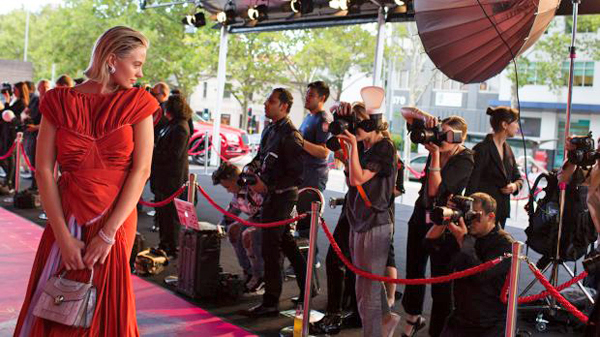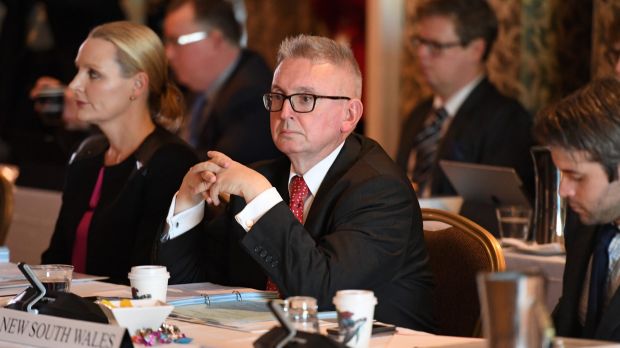By JUDITH WHITE
Corporatisation and the Powerhouse after-party
The NSW museum sector has been alarmed by reports of an alleged drunken after-party following the $1,000-a-seat Fashion Ball at the Powerhouse last month. Chair of the Upper House Inquiry into Museums and Galleries, Robert Borsak MLC raised the matter in Parliament on 6 March. Security staff, he had been told, found some of the management team in the executive offices “intoxicated, drinking Moet & Chandon in the presence of white powder”. Sounds like a scene from The Wolf of Wall Street.
Borsak’s question prompted Arts Minister Don Harwin, who had attended the ball but not the after-party, to ask director Dolla Merrilees for an urgent report on the alleged incident. Harwin later told Parliament that museum management said it had received no complaints and “strongly refuted the allegations of illegal activity”. Management is also reportedly saying that the “white powder” was just flour – something you have lying around at parties these days, apparently.
But according to a report in The Sydney Morning Herald (7 March), it was enraged professional staff who blew the whistle on the drunken gathering, and Mr Borsak has asked Minister Harwin for an “iron-clad guarantee” that the whistleblowers will not be subjected to a witchhunt.
Public Service Association general secretary Stewart Little weighed in to the controversy, saying it appeared museum management was undermining its staff and not pushing for retention of the Ultimo site.

Red carpet at the Fashion Ball
What is happening to our much-loved public cultural sector? It’s embarrassing and shameful. To me the affair is yet another symptom of the corporatisation of our cultural institutions, under the impact of many factors: governments cutting budgets, arts boards dominated by corporate heavyweights who are major political donors or dependent on government contracts, and managements hiring ever more marketing and fund-raising executives alienated from the core mission of caring for collections.
Creating that kind of structure doesn’t even work. The day after he first raised the issue in Parliament, Mr Borsak followed up by asking the Minister about reports he had received that the high-profile event raised less than $300. Mr Harwin replied that there had also been $70,000 in donations for the Australian fashion fund – a paltry sum for an event that took months to organise.
Borsak’s Upper House committee resumes hearings on 4 April, with former premier Mike Baird summonsed to answer questions about his original decision to move the Powerhouse to the Western suburbs where the Liberals are desperate to build electoral support.
Coalition policy muddle
“What matters to the community is that every program we announce, we do our homework,” said NSW Premier Gladys Berejiklian on 1 March. She was speaking about the $2.5 billion plan to rebuild Sydney’s sports stadiums, and it was the first indication that, with the State election just a year away, a rethink of the unpopular plan may be on the cards.
But when it comes to the arts, a dog seems to have eaten the Coalition Government’s homework. Ms Berejiklian and Arts Minister Harwin still appear ready to plough ahead with the controversial plan to move the Powerhouse Museum from Ultimo to Parramatta, and to give the green light for the building of the equally disputed Sydney Modern extension to the Art Gallery at a breathtaking cost of $344 million. And Cabinet is still keeping the business case for the two projects secret, despite the overwhelming weight of professional opinion against both of them.
In the past few days Planning Minister Anthony Roberts has received a number of letters that must give him pause for thought about the Development Application (DA) for Sydney Modern. They come from people who have done their homework: some of the most highly-qualified people and organisations among the huge number of objectors – 178 individuals and 17 organisations.
Letters to the Minister
Concerned about statements from his Department that the Minister would be the sole consent authority, key objectors have written to Minister Roberts asking that he refer the decision to the Independent Planning Commission. Its newly appointed chair, Professor Mary O’Kane, told the press this week that she aimed for “better, more consistent decisions, where the process is very transparent so it can be interrogated and trusted” – which is what the objectors are asking for.
The group of four leading professionals – architect David Chesterman, horticulturist Ros Andrews, arts specialist Gil Appleton and environmental lawyer Bruce Donald – points out to the Minister: “Prior to the lodging of the DA, the Government through other Ministers’ statements and its announced funding support, had already taken a position on the project. In those circumstances a decision by an independent authority with a public process is the only way to ensure public confidence in the decision on the DA.”
The Total Environment Centre, referring to “enormous public concern” about the loss of public open space, has made a similar request.
Museum consultant Kylie Winkworth, like others, spent days of work preparing her objection. She writes: “It is difficult for ordinary citizens to believe that you as Minister for Planning can appropriately review and arrive at an impartial decision on this development when the government is essentially the applicant, the funding body and, it would seem, also the consent authority.”

Area to the north of the Gallery earmarked for Sydney Modern
The National Trust has also requested an independent review of the DA, in a letter drawing attention to the “extraordinary and inappropriate situation” that no Conservation Management Plan for the Botanic Gardens and Domain was drawn up before lodging the DA. They detail not only their environmental objections but also concerns about the lack of commitment to recurrent funding for the Gallery and the need for funds elsewhere; and they draw the inescapable conclusion that it would be better to build an AGNSW satellite in Parramatta and leave the Powerhouse at Ultimo.
Back at the Gallery, meanwhile, a number of donors and benefactors are still fuming about a letter they received some weeks ago from Director of Development John Richardson, giving an “overview” of his department. It blithely informed them, “to help you in interacting with us in the future”, that there are now 14 people employed in fundraising, with grand titles including Head of Campaign, Major Gifts Manager, Philanthropy and Development Manager and Next Generation Development Manager. With State-mandated budget cuts now running at 2 per cent per year, you wonder what basic functions of the Gallery have been squeezed in order to pay the salaries and expenses of all these fundraisers, who after five years have yet to reach the $100 million in private donations towards the $344 million cost of Sydney Modern.
“Asset recycling” and the arts
With the State election looming, there’s a raft of spending plans and policy announcements coming from the Coalition Government, and Arts Minister Harwin has been busy on that front too. On 5 March he announced an “Arts 2025 Summit” to be held at Carriageworks in Sydney with 500 invited participants from across the state.
It is presented as a bold move aimed at shaping spending for the cultural sector in the coming years, and the announcement was accompanied by a motherhood statement from Mr Harwin: “The NSW Government recognises and values the profound effect that the sector has on our community, and is committed to growing and promoting a diverse, accessible and inclusive arts and cultural environment across the state.”

Arts Minister Don Harwin
If the Minister’s sentiments are genuine, will the summit agenda allow the handpicked participants to challenge existing policies? Will any of the handpicked delegates raise the thorny subject of the laughably-named “efficiency dividend”, the annual budget cut which is crippling work in the sector? Or question the apportioning of cultural infrastructure funds?
Take the allocation of $25 million a year for four years in regional cultural infrastructure. It’s a small amount compared to the huge sums being spent in Sydney, and does nothing to address recurrent costs for struggling regional institutions.
In one of the box-ticking exercises at which the Government is adept, an online survey and a series of local meetings was recently organised by way of “consultation” about the allocation of the $100 million, with results to be announced at the end of this month. One attendee was deeply disappointed to hear from an official that there was no question the metropolitan projects would be going ahead.
It has to be asked: where is the Opposition in all this? On 7 March, during Minister Harwin’s eventful day in the Upper House, he was spruiking his regional policy in answer to a Dorothy Dixer when Labor MLC Penny Sharpe was twice called to order by the Speaker. Rather than heckling inside Parliament, Luke Foley’s ALP should be out in the community putting forward its own policy for arts and culture. We have yet to see it.
The Baird-Berejiklian “asset recycling” program – selling off publicly-owned facilities for a one-off splurge on vote-winning plans and vanity projects – is bad policy not least for the arts. Putting up buildings at the behest of the big end of town is no substitute for ongoing funding. To allow the Coalition to get away with such an excuse for investment in culture – that would be a real scandal.

Berejiklian and Baird – Premiers for “asset recycling”





Any police investigation into the white powder found adjacent to the sozzled ezzecutives?
If not, why not?